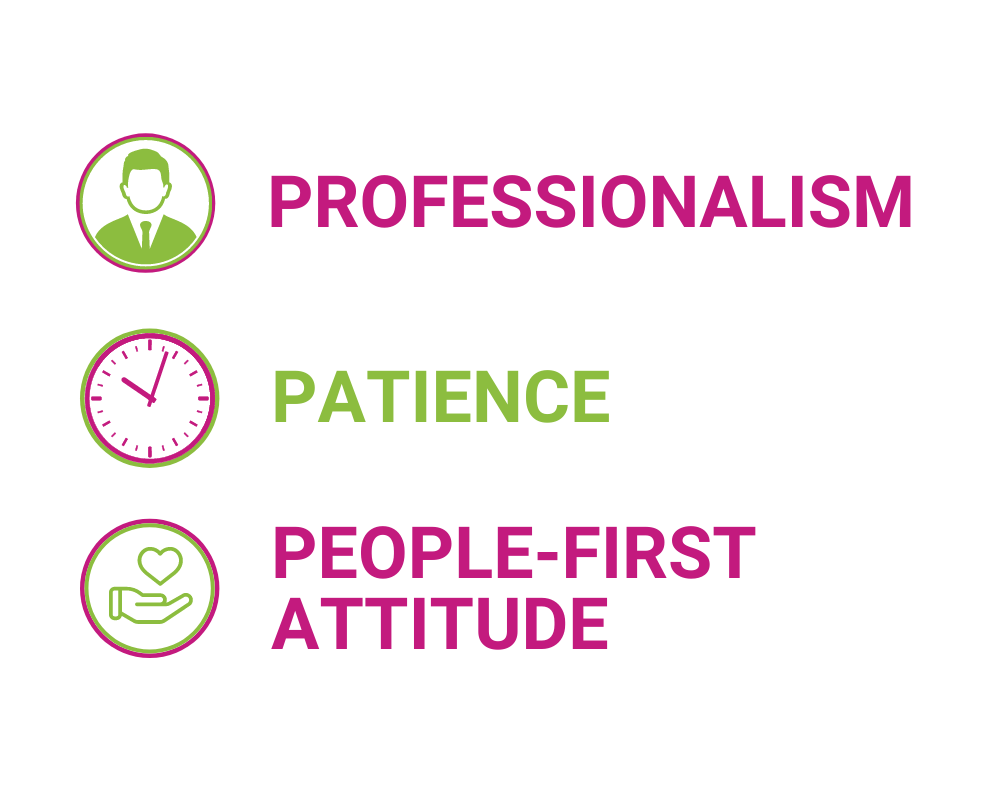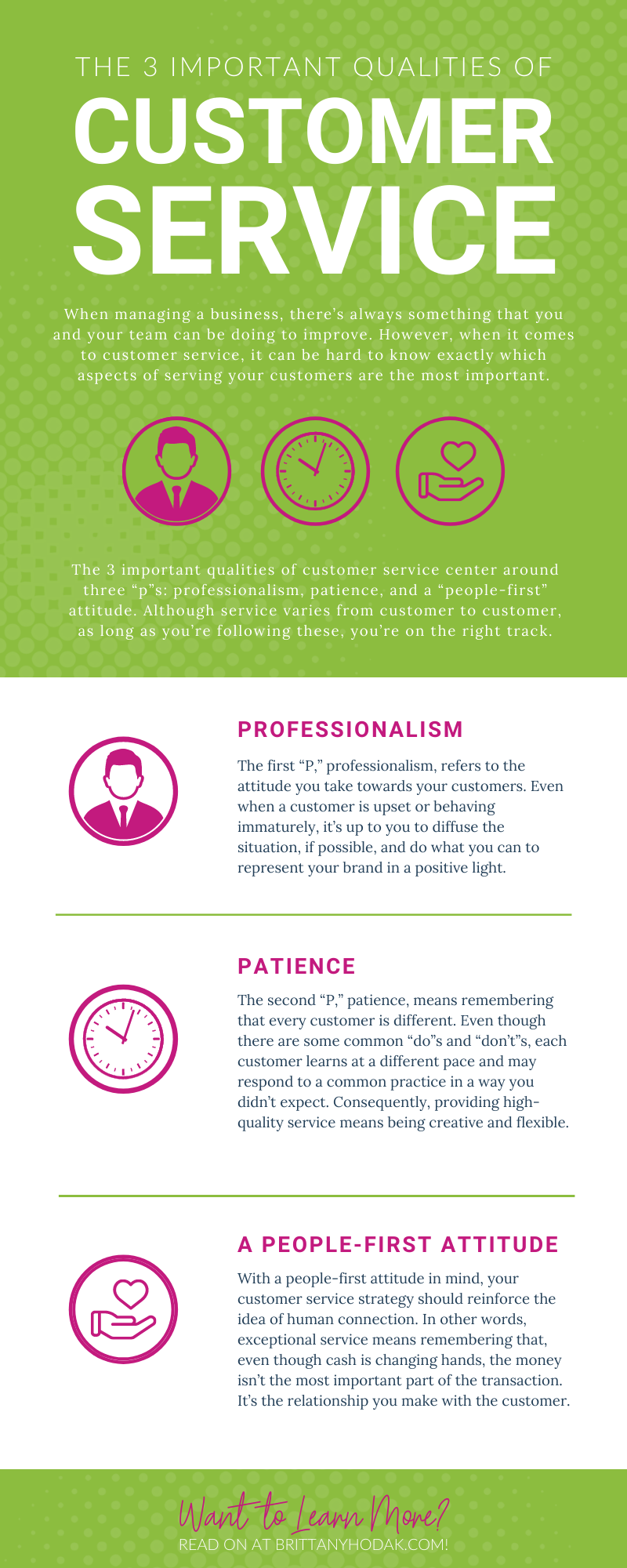When managing a business, there’s never a shortage of work to be done. Whether you’re focused on sales numbers, marketing strategies, or internal organization, there’s always something that you and your team can be doing to improve. That said, when it comes to customer service, it can be hard to know exactly where to focus your improvement efforts. Should I be adjusting my customer support hours? Should I be hiring more customer-facing employees? Maybe I should re-think my customer service approach altogether? Answering any of these questions isn’t easy. However, combined, the real concern is where to focus first, begging the question “What are the 3 important qualities of customer service?”
Essentially, the 3 important qualities of customer service center around three “p”s: professionalism, patience, and a “people-first” attitude. Although customer service varies from customer to customer, as long as you’re following these guidelines, you’re on the right track.
Here, we’ll break down the 3 important qualities of customer service in more detail. We’ll also touch on a few leaders in customer service, so you can follow in their lead if you’re unsure what high-quality customer service should look like. Let’s get started! 🙌
The Three P’s of High-Quality Customer Service
To get an idea of why the three “P”s matter, first, let’s break down what they are. The first “P,” professionalism, refers to the attitude you take towards your customers. Even when a customer is upset or behaving immaturely, it’s up to you to diffuse the situation, if possible, and do what you can to represent your brand in a positive light.

The second “P,” patience, means remembering that every customer is different. Even though there are obviously some common “do”s and “don’t”s, each customer learns at a different pace and may respond to a common practice in a way you didn’t expect. Consequently, providing high-quality service means being creative and flexible.
Finally, the third “P,” a people-first attitude, builds off of professionalism and patience. With this attitude in mind, your customer service strategy should reinforce the idea of human connection. In other words, exceptional service means remembering that, even though cash is changing hands, the money isn’t the most important part of the transaction. It’s the relationship you make with the customer.
We’ll discuss each of these 3 important qualities of customer service below, in more detail. That way, you won’t just know what you “should” do. You’ll also know how to confidently turn each insight into action.
Practicing Professionalism in Customer Service
First and foremost, let’s look at professionalism. Of the 3 important qualities of customer service, professionalism is arguably the most basic and the first one we’re expected to demonstrate when entering the workplace. However, when serving a frustrated customer, staying poised can be easier said than done, and, ultimately, it takes practice and experience to ensure you are confident and level-headed at all times. Below are the most important components of professionalism in customer service.
Staying Cool, Calm, and Collected
From the outside, professionalism first means staying calm and collected at all times. If a customer is upset about a product, an experience with an employee, or simply the situation at hand, it can be easy to get defensive and respond to their complaints with the same tone and volume. However, mirroring a customer’s behavior when they’re unhappy rarely solves the problem. Keeping calm, on the other hand, provides reassurance that their concern is solvable and that you’re there to help.
In retail environments, for example, there are countless examples of employees calming a disgruntled customer. During a recent trip to the grocery store, for instance, I saw a customer complaining loudly about a missing product. It was a sale item, she yelled, and because the shelf was empty, they were robbing her of the reduced price. She also insisted that it was the fault of the employee in front of her, despite the fact that he appeared to be the deli manager, not a member of the stock team. Nevertheless, despite her attitude and raised voice, he remained calm and walked her to the store’s customer service desk, assuring her throughout the walk that she would receive a raincheck and be given the sale price once the item was back in stock.
Ultimately, because the deli manager was so cool and matter-of-fact, the customer visibly relaxed and left the store with her problem solved. Likewise, in your own business, exercising the 3 important qualities of customer service means staying calm and solving problems. That way, you not only minimize the customer’s unhappiness. You also present your brand in a professional manner, making them more likely to return, even if their needs can’t immediately be met.
Pro Tip:
As a rule, empower every employee to make decisions below a certain dollar amount. The “right” dollar amount will depend on your business model and approximate lifetime value of a customer, but somewhere between $20 and $100 is probably right. In the example above, the product probably cost less than $10. It’s not worth anyone’s time to elevate that complaint to another person — and, it’s certainly not worth losing a customer (even if it’s a Crazy Karen!) because she’s frustrated that it took “speaking to a manager” to solve the complaint. Train your associates to look for quick, acceptable solutions while keeping the first “P” top of mind.
Seeing Bad Customer Experiences as a Learning Opportunity
Speaking of bad experiences, professionalism in customer service also involves seeing every experience as a learning opportunity. Like an argument with a friend or family member, experiences with tough customers usually stem from both sides of the situation. Because of this, even if a customer is taking an immature tone or reacting in an over-the-top way, there’s still usually a valid reason that they’re unhappy. Look for that reason and focus on how to solve it so you can prevent similar confrontations in the future.

It’s not always easy, but there is always a way to take a negative experience and spin it into a chance to learn and improve. Below are a few examples to kickstart your positivity.
- When a customer complains that you don’t have an item in stock, it’s an opportunity to evaluate your stocking process.
- When a customer brings up a concern about an employee’s behavior, it’s a chance for you to evaluate their performance. Maybe they’re facing personal challenges that are making their time at work more difficult. Maybe they handled the situation poorly and could use more support from their fellow team members.
- If a customer is unhappy with a product or service, it’s an opportunity to adjust it or switch to a new brand altogether (if you’re in a retail environment). Who knows? One small improvement might mean a world of difference for your customers.
At the end of the day, the key to seeing bad experiences as opportunities is remembering that, with each unhappy customer, you’re there to help mend the professional relationship. In other words, practicing the 3 important qualities of customer service doesn’t just mean turning a contentious situation into a calm one. It also means learning from the situation, so that it doesn’t arise again with other customers.
Investing in Your Employees as Much as Your Customers
The last component of professionalism is a simple one: treating your employees just as well as your customers. For many business owners, it’s easy to get into the “eye on the prize” mindset and focus on customers above all else. However, when customer happiness is valued more than employee happiness, the latter tends to decrease. At that point, if employees are unhappy, they can no longer help customers be happy. Essentially, the business owner built the entire customer service strategy on a cracked foundation.
To avoid this, creating a professional customer service environment means empowering your employees just as much as you support your customers. Google, for example, has consistently received praise for its company culture and the benefits they offer their employees. In addition to the standard perks, such as health insurance and 401Ks, these benefits include rare amenities such as free food, dog-friendly offices, and an onsite fitness center. Employees are also encouraged to follow the “80/20 rule,” devoting 80% of their working hours to existing projects and using the other 20% for creative space to develop new ideas. Because of these benefits, Google has not only grown dramatically over the last two decades. It’s also more than doubled its customer satisfaction ratings and grown its annual revenue from $1.5 billion in 2003 to $280 billion in 2022. That’s a massive return on investment from treating employees exceptionally well!
In the same way, whether you’re a giant in your niche, like Google, or a mom-and-pop shop, exemplary customer service on the front end of your business is only possible when there’s an exemplary work environment behind the scenes. Remember, happy employees create happy customers. Looking at the 3 important qualities of customer service, it doesn’t get much simpler than that, right?
Exercising Patience in Customer Service
Well, that just about wraps up the “professionalism” aspect of the three “P”s. Next up in the 3 important qualities of customer service is the second “P’: patience. Generally speaking, if professionalism is the foundation of a good customer service strategy, patience is like the frame. Although it’s not always explicitly stated, it’s one of the key components of any interaction with a customer and, without it, a calm interaction can quickly become problematic. Consequently, the importance of patience – with yourself, your team members, and your customers – cannot be understated. Below are a few common ways to practice patience and work it into your existing service guidelines.
Adjusting to Meet Customer Needs Where Possible
One way to show patience with customers is by being flexible with company protocols. Although it’s undeniably a good rule of thumb to have general service guidelines for yourself and your team, sometimes a customer may require a helping hand to achieve the same experience you provide for the average customer. In these situations, exceptional customer service involves stepping outside of your standard rules to lend that hand.
Susan Greene, a copywriter from Orlando, recently shared an experience in which a Publix Super Market employee did just that. In Green’s words, the experience went as follows:
“My 3-year-old niece loves riding in Publix’s kids’ shopping carts that look like a car, complete with a steering wheel. One time, all those carts were in use and my niece was disappointed to find she’d have to ride in one of the plain carts. Without our knowing it, one of the Publix employees recognized the situation. He kept an eye on the checkout lines, and, when one of the kids’ carts became available, he snagged it and searched for us in the store. He offered us the cart and even helped us transfer our groceries into the car cart. His extra effort delighted my niece, which in turn delighted me.”
In this case, while the cart wasn’t necessarily a need for Green and her niece, the employee went above and beyond to make sure their preferences were accommodated. This not only ensured that they had the best experience possible on that day, but also ensured they would return, simply because of the superb customer service. Likewise, practicing patience isn’t just a way to reinforce the 3 important qualities of customer service. It’s also a proven way to turn customers into evangelists for your brand (or “superfans,” as I call them). Win, win!
Allowing Customers to Grow at Their Own Pace
In addition to being flexible, exceptional customer service isn’t “one size fits” all, and every customer is unique. Consequently, a second way to work patience into your service guidelines is by allowing customers to move at their own pace. Whether you’re helping them through a difficult problem or answering a single question, what seems simple to you may be confusing to your customer. By allowing them to control the pace of the interaction (i.e. not rushing them), you efficiently and calmly bring them up to speed. That way, everyone leaves happy and fulfilled.

This is especially true if your organization works with customers across a wide variety of backgrounds or age groups, like a software or technology company. A friend of mine, for instance, spent a year working for a customer relationship management (CRM) software business. There, even though many customers learned the software effortlessly, others struggled to get started. For them, it wasn’t as simple as they’d originally hoped, and the complexity of the CRM felt overwhelming. Knowing this, my friend offered these customers additional support meetings, so they could learn the system with her help. Even if it took four, five, even six more meetings than she generally offered new customers, this allowed these customers to learn at their own speed, making them happier and more likely to use the tool in the long run.
Similarly, in your own business, allowing customers time to learn and grow at their own pace is yet another way to demonstrate that you genuinely care and want them to be happy with your product or service. Misty Larkins, who is the President of a growth marketing agency, says “you don’t have to rush a customer, it’s ok to engage customers in a meaningful way with content or some other communication that will earn their trust and make them more connected to the brand.” Sometimes educating and allowing a customer to move at their own pace is the best way to engage a customer so that they stay in the long-term.
Practicing Self Care After Tough Customer Experiences
That said, providing an exceptional level of customer service can be tiring, even at the best of times. After all, if you’re going “above and beyond” for every customer, you’re expending a lot of physical and mental energy! Therefore, part of the 3 important qualities of customer service is being patient with yourself as well as your customers. Again, among your team members, no one can create happy customers if they’re not happy and supported first. That includes you, too!
One company that supplies self-care resources is CHG Healthcare. Because healthcare is an unpredictable and challenging industry, CHG focuses on managing its employees’ stress. CHG began offering employees free counseling in 2016. Since then, they’ve served more than 75 employees on a consistent basis. This not only allowed employees to care for themselves mentally. It also reduced the stigma around mental health in the CHG workplace. That way, when times were tough, staff could heal themselves before getting back to healing others.
Likewise, with your own team, remember to take time for yourself as well as your customers. That way, no one’s overworked and customers are happy. Plus, you’ll be well on your way to being a “best place to work,” too. 💓
Maintaining A “People-First” Attitude in Customer Service
Last but not least, the third “P” of the 3 important qualities of customer service is a people-first attitude. Although a professional and patient approach is important in customer interactions, the biggest factor in high-quality service is basic humanity. Ask yourself, “Do my customers feel heard and understood when they voice a concern?” “Do they feel valued and appreciated when they make a purchase?” and “Do they know that my team and I view them as a person, not a sale?” To answer each of these questions with a “yes,” start with the three steps below.
Empathizing With Customers
Maintaining a people-first attitude first means expressing empathy for your customers. In many cases, customers aren’t just complaining because of a concern for your product or service. Like all of us, they’re also juggling personal and professional concerns. This makes their apprehension for your brand just the tip of the iceberg. Showing empathy for your customer’s struggles – related to your business or not – isn’t just a sure way to improve their day. It’s also guaranteed to make them feel heard, increasing the chance they turn into a regular.

For example, a Traders Joe’s customer shared the story of how the brand helped his family through a tough time. The story is especially impressive because they were first-time customers. In the viral Reddit post, the man explained that his 89-year-old grandfather lived alone. Though normally comfortable, in a recent snowstorm, he’d been unable to travel to the store for groceries. In response, the man’s mother called a number of grocers in the area to see if they would deliver. He no longer had food and she didn’t live close enough to purchase them herself. Although most of the stores refused, Trader Joe’s said they would make an exception. According to the writer, they then helped his mother choose appropriate items and delivered them in less than an hour. They even covered the cost of the food, telling the writer’s mother to have a “Merry Christmas.”
Since the original posting, thousands of people have left comments. In each comment, a user shares a similar experience in which Trader Joe’s demonstrated empathy. As a result, they have created life-long customers.
Personalizing & Connecting With Customers
The second component of a people-first attitude is personalizing and connecting with customers. Like the “professionalism” and “patience” segments of the 3 important qualities of customer service, a people-first attitude centers around creating a long-term relationship between your company and each customer. To foster these relationships, the best companies find ways to personalize their customers’ experiences. Ideally, these ways, while meaningful, aren’t expensive.
One opportunity for personalization – and my favorite option – is through client gifts. Regardless of when you give it, a personalized gift is a physical representation of your appreciation for your customers. It shows that you care about them as an individual, understand their interests, and value their support. Below are a few of my tried-and-true favorite gift ideas.
- Custom office items: Not only will a custom tumbler, candy jar, or office supply show you care. It’s also something they can use every day.
- Relaxation gifts: Have a client who works as hard as you do? Show them your appreciation with a spa set or gift certificate.
- Family fun packages: For clients who value their free time, give a gift for their whole family. Think “experience” gifts, like concert tickets, a wine tasting, or free passes to an amusement park.
These are just a few ways you can personalize the experience and implement the 3 important qualities of customer service. Check out my “Free Stuff” page for a downloadable gift guide with more than 75 ideas for standout gifts.
Following the Platinum Rule

Lastly, maintaining a people-first attitude essentially means following the “Platinum Rule.” First publicized in the 1998 bestseller, The Platinum Rule, this rule means “learning to really understand other people and then handling them in a way that’s best for them, not just for us”. Take the time to figure out the people around us, and then adjust our behavior to make them more comfortable.” We all know the Golden Rule, “Do unto others as you’d have done unto you.” However, the Platinum rule states that good customer service requires we “Do unto others as they’d like done unto them.” In this way, you showcase the effort you’re willing to invest in each customer’s experience. As a result, you also encourage them to monetarily invest in your products/services for years to come.
Frequently Asked Questions:
Q1: How does AI impact customer service today?
A: AI has become a game-changer in customer service, helping businesses offer faster and more personalized experiences. Chatbots and automated systems can address common queries, allowing human agents to focus on more complex issues. However, AI should complement—not replace—the human qualities of professionalism, patience, and empathy, ensuring that customers still feel valued and understood in every interaction.
Q2: Can AI still maintain a people-first attitude in customer service?
A: AI tools are becoming more sophisticated in mimicking empathy, but they cannot fully replace the human touch required for a genuine “people-first” attitude. While AI can handle basic inquiries and offer assistance 24/7, human agents are crucial for showing true empathy, understanding customer emotions, and building strong, meaningful relationships that drive customer loyalty. Use AI to free up more of your time so that you can deliver more personalized interactions with customers.
Q3: How do I handle negative customer feedback without damaging my brand?
A: Negative feedback is an opportunity for growth. The key is responding quickly and professionally, acknowledging the issue, and offering a solution. Show empathy and understanding by addressing the customer’s concerns and offering a clear plan of action to resolve the issue. A well-handled complaint can actually strengthen the customer’s loyalty.
Q4: How can I transform my customer service team into advocates for my brand?
A: Building a customer-centric culture starts with training your team to go beyond just resolving issues—they should actively advocate for your brand and its values. To do this, consider investing in comprehensive customer experience training, such as the Six Weeks to Superfans Masterclass. This program helps entrepreneurs and their teams go from reactive to proactive in delivering exceptional service by transforming employees into Acting Chiefs of Experience. When your team understands the “why” behind customer interactions, they’ll naturally become advocates, creating lasting relationships that turn customers into superfans.
Q5: How can I make sure my team uses AI tools effectively without sacrificing the quality of customer service?
A: To balance AI and human interaction, it’s important to set clear guidelines for when AI is appropriate and when it should hand off to a human agent. AI should be used to streamline workflows, like routing requests or answering basic questions. For complex or emotional matters, human agents should step in, ensuring that customers always feel supported by a real person when needed.
Q6: How can I measure the success of my customer service efforts?
A: Success can be measured through key performance indicators like Customer Satisfaction (CSAT) scores. A CSAT score is typically gathered by sending a survey after a customer interaction, asking them to rate their satisfaction on a scale (often from 1 to 5 or 1 to 10). This score provides a snapshot of how happy customers are with the service they received, offering valuable insights into areas for improvement. In addition to CSAT, it’s essential to monitor customer feedback and social media sentiment, which can reveal how well your team is performing in terms of professionalism, patience, and a people-first attitude.
For more customer service insights, check out my book, Creating Superfans.

